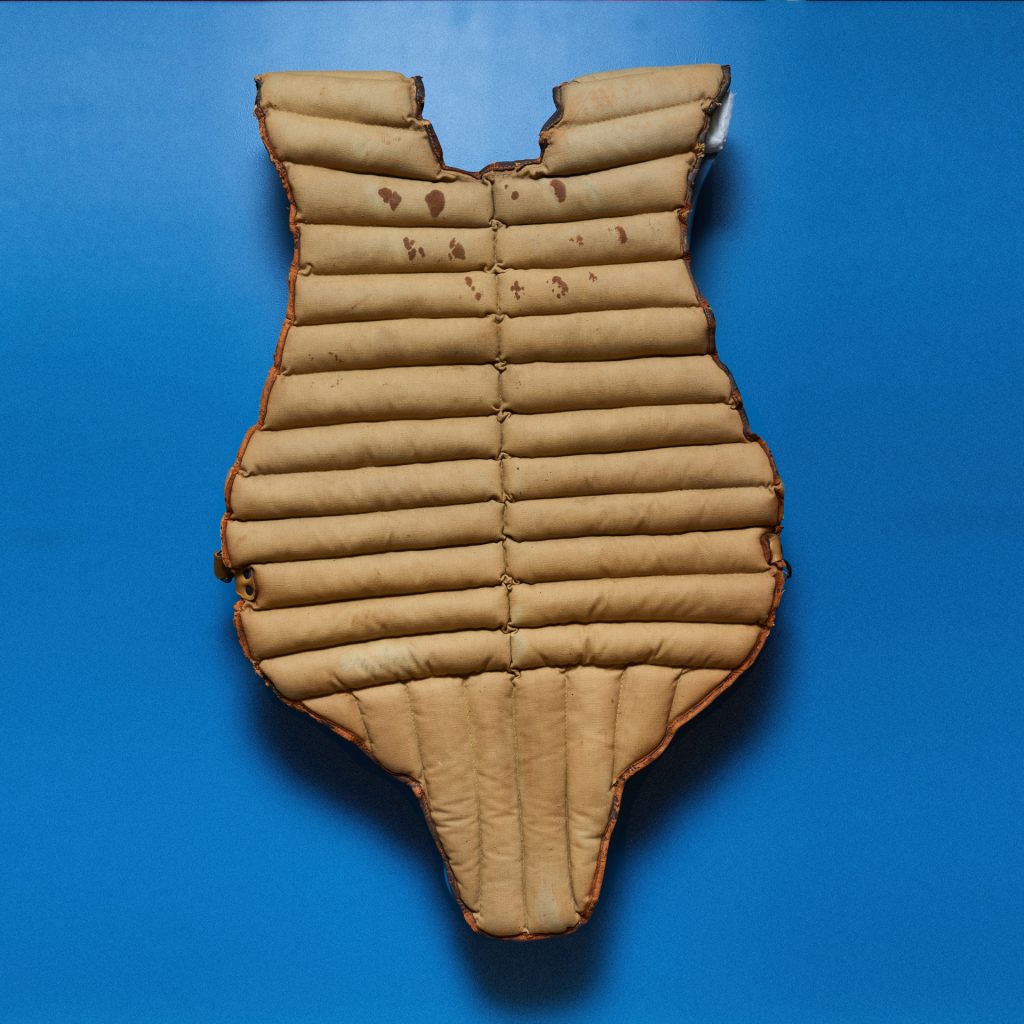Chest guard used by the Jewish baseball player Moe (Morris) Berg (1902-1972) USA, 1930s
Cotton, leather, metal
Courtesy of Jonathan Blank
Berg was a catcher in several Major League Baseball clubs and spoke many languages – including Japanese. In 1934, during a tour to Japan in with other baseball stars, he was asked by the US Intelligence to photograph local army facilities. In 1944-5 he traveled to Germany several times to help US forces capture German nuclear scientists. After the war he was awarded the Medal of Freedom, the highest honor given to civilians during wartime, yet he refused to accept it.
Must Know
Berg was born in 1902 to an immigrant Jewish family from Ukraine who grew up in Harlem. When he was 8 years old, the family moved to Newark, a town in New Jersey, where his father Bernard opened a pharmacy. At the same time, covert and overt antisemitism was still common. Many Jews were not accepted into middle-class circles and only a few had children who were able to enrol into the prestigious universities. Berg, who had a talent for languages, finished high school at the age of 16 at the same time that the First World War ended, and was accepted to study at Princeton – one of the most prestigious academic institutions in the world. At Princeton he had to overcome overt hostility from his classmates and faculty due to his background and origin.
he received a B.A., magna cum laude in modern languages, and spoke 12 languages; among them is ancient Greek, Latin, Sanskrit, French, Spanish, German, Yiddish and hebrew. In addition, during his studies he was a successful baseball player. Berg stood out and excelled in the university team’s traditional match against Yale university, where his team were victorious. His performance caught the eye of the managers of the baseball teams the New York Giants and the Brooklyn Robins (later Dodgers), who both wanted “Jewish blood” to appeal to the Jewish community in New York.
From 1923 he played for the Robins for two years, and to his father’s chagrin, his career began as a professional baseball player, in the position of a catcher. At the same time, Berg signed up for law school at Colombia, partly to please his father, and although he completed his studies, he never practiced law. Instead, his career as a player and then as a coach in Washington and Boston, flourished. However, when he moved to play and coach in Washington, he became interested in international politics and was invited to diplomatic events and cocktail parties.
Berg applied to work as a spy for the U.S. following the rise of Italian fascism, German Nazism and nationalism and militarism in Japan. The turning point was in November 1934. Although he was already in the later stages of his career, Berg joined a baseball team that embarked on a friendship campaign in Japan. During a group tour in Tokyo, Berg sneaked onto the roof of a hospital and took many pictures of the capital and of Tokyo Bay. When the Second World War broke out, these pictures, together with the ties he had cultivated and his high command of several languages, were his ticket into the American intelligence community. he showed the footage to the intelligence officers and these helped them to plan the air force’s attacks on the Japanese capital. In 1943 he was drafted into the Office of Strategic Services (OSS), which four years later served as the basis for the establishment of the Central Intelligence Agency (CIA).
More Info
Berg underwent months of gruelling training before being attached to the Office of Strategic Services (OSS) and sent for espionage tasks and secret meetings in Europe. Among other things, he was tasked with extracting Italian scientists who had relationships with their Nazi counterparts and information on the pace of the German nuclear program. The goal was to transfer them to the U.S. and to attach them to the ‘Manhattan Project’ – the secret nuclear program.
Another of his tasks, and probably the most famous one, was to trace Werner heisenberg, Germany’s renowned nuclear scientist. heisenberg arrived in Zurich in December 1944 to give a lecture. Berg’s mission was to listen to the lecture and determine if there were any indications that Germany was close to producing an atomic bomb. After listening to heisenberg’s lecture, he concluded that Germany was a long way from producing nuclear weapons.
In 1951, during his visit to the U.S., he met with Prime Minister David Ben-Gurion, the director of the CIA, General Walter Bedell Smith, and with the help of his aides Reuben Shiloh and Teddy Kollek, he helped to establish the relationship between the Israeli Mossad and its American counterpart. In the same year, Berg begged his managers to send him as the first representative of the organization to Israel. “A Jew must do it”, he wrote in his diary. However, the CIA, who at that time suspected that Israel was an ally of the Soviet Union, refused.
According to a film made about him and according to his brother Samuel, Berg spent the last 20 years of his life without permanent employment. he moved around between his friends’ apartments and lived mainly with Samuel, who admitted that his brother was moody and that it was only in his books that he found comfort.
Berg passed away in 1972, and in his will he asked for his ashes to be scattered over Mount Scopus in Jerusalem.

